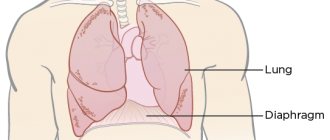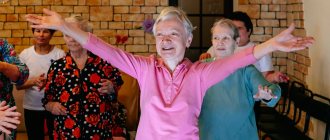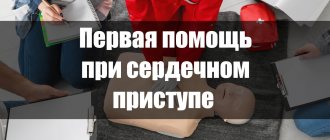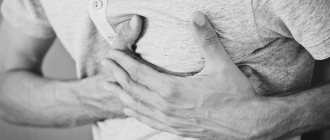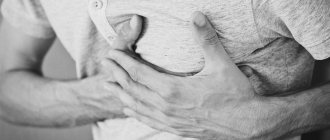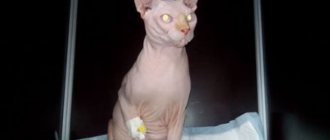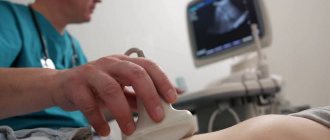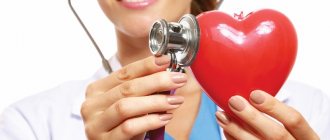First aid for hypertensive crisis
Hypertensive crisis
is a condition manifested by high blood pressure (BP) (systolic or “upper” blood pressure, usually more than 180 mm Hg; diastolic or “lower” blood pressure - more than 100 mm Hg) and the following main symptoms:
• headache, often in the occipital region, or heaviness and noise in the head;
• flashing “flies”, a veil or a net before the eyes;
• nausea, feeling of exhaustion, overwork, internal tension;
• shortness of breath, weakness, constant monotonous aching pain/discomfort in the heart area, sometimes the appearance or increase of pastiness/swelling of the skin of the face, arms, legs.
Algorithm for emergency actions in case of hypertensive crisis (advice to the patient)
If symptoms of a hypertensive crisis appear, you must:
• remove bright light, ensure peace, access to fresh air (unbutton your shirt collar, ventilate the room, etc.);
• measure blood pressure and, if its upper level is greater than or equal to 160 mm Hg. Art., you must take an antihypertensive drug previously recommended by your doctor. In the absence of a doctor-recommended antihypertensive drug or when a blood pressure level is recorded above 200 mm Hg. Art. urgently need to call an ambulance;
• before the arrival of emergency medical services, you must (if possible) sit in a chair with armrests and take a hot foot bath (put your feet in a container of hot water).
Attention!
A patient with a hypertensive crisis is prohibited from any sudden movements (suddenly standing up, sitting down, lying down, bending down), pushing hard and any physical activity.
• 40-60 minutes after taking the medicine recommended by the doctor, it is necessary to re-measure blood pressure and, if its level has not decreased by 20-30 mm Hg. Art. from the initial state and/or the condition has not improved, call an ambulance immediately.
• If you feel better and your blood pressure decreases, you need to rest (go to bed with the head of the bed raised) and then contact your local (family) doctor.
Algorithm of actions in case of cardiac arrest
First aid for cardiac arrest:
- lay the patient on a flat, hard surface with his back, place a cushion formed from improvised means under his head;
- place hands folded like a butterfly on the lower third of the person’s sternum and perform jerking movements at a speed of 60-65 times per minute. They must be very strong
(professional resuscitators often break patients’ ribs during chest compressions. But in terms of bringing a person back to life, this is a justifiable injury);
- if possible, a second person performs artificial respiration, but if there is only one resuscitator, you should alternate 1 breath for 5-6 pushes;
- After a while, you need to evaluate the effectiveness of actions. With positive dynamics, a pulse appears in the carotid and peripheral arteries, the skin acquires a “live” pink tint, pressure rises, and the ability to breathe independently is restored.
Even if there is no effectiveness, it is necessary to continue the measures until the team arrives; this will preserve the vital functions of the body and prevent the development of irreversible consequences caused by brain hypoxia.
First aid for acute heart failure
Acute heart failure (AHF)
is a serious pathological condition that develops in patients with various heart diseases and hypertension. This is one of the most common reasons for calling an ambulance and hospitalization of patients, as well as mortality in our country and around the world.
The main manifestations (symptoms) of acute heart failure are:
• heavy, frequent (more than 24 per minute) noisy breathing - shortness of breath, sometimes reaching the level of suffocation, with predominant difficulty in inhaling and a clear increase in shortness of breath and cough in a horizontal position. A sitting position or a lying position with the head of the head raised up alleviates the patient's condition;
• often when breathing, wet, squelching wheezing/sounds, interrupted by coughing, become audible; in the terminal stage, breathing takes on a bubbling character with the appearance of foam at the patient’s mouth;
• characteristic sitting posture of the patient, resting his straight arms on his knees or on the seat (to facilitate breathing).
Acute heart failure can develop very quickly and lead to the death of the patient within 30-60 minutes. In most cases, 6-12 or more hours pass from the first clinical signs to severe manifestations of AHF, but without medical care, the absolute majority of patients with AHF die.
Algorithm of emergency actions for acute heart failure (advice to the patient)
If the above symptoms of AHF appear in patients with hypertension or heart disease, it is necessary:
• call emergency medical assistance;
• give the patient a sitting position, preferably in a chair with armrests on which he can lean and engage the intercostal muscles in the act of breathing;
• provide physical and psycho-emotional peace and fresh air by ventilating the room;
• place your feet in a large container (basin, tank, bucket, etc.) with hot water;
• in extremely severe cases, tourniquets are applied to the legs in the groin area, compressing the superficial veins, but not the deep arteries, which reduces blood flow to the heart and thereby facilitates its work.
If the patient or first aid provider has experience in the use of nitroglycerin, it is prescribed in a dose of 0.4 (0.5) mg (inhalation into the oral cavity is carried out under the root of the tongue, the tablet/capsule is placed under the tongue, the capsule must first be bitten , do not swallow). If the patient’s well-being improves after using nitroglycerin, it is reapplied every 10-15 minutes until the arrival of the emergency medical team. If there is no improvement in the patient’s well-being after the next dose of nitroglycerin, the drug is no longer used.
Attention!
A patient with AHF must exclude all physical activity; it is strictly forbidden to walk, smoke, drink water and take liquid food until special permission from the doctor; Nitroglycerin should not be taken if blood pressure is less than 100 mmHg. Art. with severe headache, dizziness, acute impairment of vision, speech or coordination of movements.
All patients with hypertension or heart disease with shortness of breath and swelling in the legs should discuss with their doctor what medications should be taken if AHF develops, clearly write down their names, dosage and time sequence (algorithm) for taking them, and also check with the doctor if what manifestations of the disease require urgent medical attention. Each such patient needs to create an individual first aid kit for AHF and constantly have it with him.
Causes of AHF
Automaticity of the heart - the ability to contract rhythmically can decrease due to heavy loads. Acute heart failure can manifest itself when the elasticity of the myocardial walls decreases due to inflammation caused by pathogenic bacteria and infections entering the patient’s blood after a viral disease (sore throat, meningitis, pneumonia, etc.). AHF can also be caused by diseases associated with impaired myocardial function.
In most cases, the patient's heart cannot eject the required volume of blood or accept the required amount into the ventricles. The main causes of acute heart failure:
- Diseases that reduce the contractile activity of the heart muscle: heart attack, myocarditis, surgery using an artificial respiration system.
- Weakening of the function of the heart muscle caused by impaired coronary circulation.
- Cardiac tamponade. Accumulation of fluid in the pericardial cavity, which leads to irregular contractions of the heart due to compression of the cavities.
- Hypertensive disease (hypertension), in which blood pressure rises above normal.
- Functional and morphological changes in the structure of heart valves and myocardium.
- Arterial hypertension, expressed as increased pressure in the system.
- Arrhythmia is a pathological condition that is accompanied by a violation of the heart rate, a change in the sequence and rhythm of heart contractions.
The following factors can also cause heart failure: focal brain damage due to stroke, electrical injury, brain injury, drug poisoning or ethyl alcohol intoxication.
First aid for acute cerebrovascular accident (ACVA)
The main signs (symptoms) of acute cerebrovascular accident:
• numbness, weakness, “disobedience” or paralysis (immobility) of an arm, leg, half of the body, distortion of the face and/or drooling on one side;
• speech disorders (difficulties in choosing the right words, understanding speech and reading, slurred and unclear speech, up to complete loss of speech);
• disturbances or loss of vision, double vision, difficulty focusing;
• imbalance and coordination of movements (feelings of “swaying, sinking, body rotation, dizziness”, unsteady gait up to falling);
• unusual severe headache (often after stress or physical exertion);
• confusion or loss of consciousness, uncontrollable urination or bowel movements.
If any of these signs suddenly appear, call an ambulance immediately, even if these manifestations of the disease were observed for only a few minutes
Before the emergency medical team arrives:
• If the patient is unconscious, lay him on his side, remove removable dentures (food debris, vomit) from the mouth, make sure that the patient is breathing.
• If the victim is conscious, help him to a comfortable sitting or semi-sitting position in a chair or on a bed, placing pillows under his back. Provide fresh air. Unbutton your shirt collar, belt, waistband, and remove tight clothing.
• Measure your blood pressure. If its upper level exceeds 220 mm Hg. Art., give the patient a drug that lowers blood pressure, which he took before.
• Measure your body temperature. If t=38°C or more, give the patient 1 g of paracetamol (2 tablets of 0.5 g, chew, swallow). If paracetamol is not available, do not give other antipyretic drugs!
• Put ice on your forehead and head, you can take food from the freezer, put in waterproof bags and wrapped in a towel.
• If the patient has previously taken drugs that lower blood cholesterol from the statin group (simvastatin, lovastatin, fluvastatin, pravastatin, atorvastatin, rosuvastatin), give the patient the usual daily dose.
• If the victim has difficulty swallowing and saliva is dripping from his mouth, tilt his head towards the weaker side of the body and blot the dripping saliva with clean tissues.
• If the victim is unable to speak or has slurred speech, reassure and reassure him that the condition is temporary. Hold his hand on the non-paralyzed side, stop him from trying to talk, and don't ask questions that require an answer. Remember that although the victim cannot speak, he is aware of what is happening and hears everything that is said around him.
For the visually impaired
It is important to know! First emergency aid for cardiovascular diseases
T.N. Bolgova, a therapist at the Department of Prevention and Medical Examinations, recalls the risk factors for cardiovascular diseases, as well as the first urgent actions in emergency situations.
In our country, up to 80% of deaths occur outside of medical institutions - at home, at work, in the country, in public places, most of them occur suddenly.
Statistics show that many patients (or their relatives) call emergency medical care late, which reduces the likelihood of rescue.
By mastering the necessary first aid skills in the form of self- or mutual aid, in most cases you can save the patient’s life.
First aid for a heart attack
Characteristic signs of a heart attack (myocardial infarction):
• sudden (paroxysmal) pressing, squeezing, burning, aching pain in the chest (behind the sternum), lasting more than 5 minutes;
• similar pains are often observed in the left shoulder, left shoulder blade, left half of the neck and lower jaw, both shoulders, both arms, the lower part of the sternum along with the upper abdomen;
• lack of air, shortness of breath, severe weakness, cold sweat, nausea - often occur together or follow/precede discomfort/pain in the chest;
• often these manifestations of the disease develop against the background of physical or psycho-emotional stress, but more often with some interval after them.
Uncharacteristic signs that are often confused with a heart attack:
• stabbing, cutting, pulsating, drilling, constant aching pain for many hours and pain in the heart area that does not change in intensity.
Advice for a patient having a heart attack
If you or someone else suddenly has the above mentioned signs of a heart attack that last more than 5 minutes, don’t hesitate, call an ambulance immediately!
If you have symptoms of a heart attack and there is no way to call an ambulance, then ask someone to take you to the hospital - this is the only right decision. Never drive yourself!
If a heart attack occurs, you must follow the instructions received from your attending physician (if there are none) or act according to the following algorithm:
1. Sit in a chair with an armrest or lie in bed with the head of the bed raised.
2. Take 0.25 g of acetylsalicylic acid (chew the tablet, swallow).
3. Nitroglycerin – spray one inhalation dose into the mouth.
4. Free your neck, ensure the flow of fresh air (open the vents, windows).
If the pain persists, it is imperative to call an ambulance and take nitroglycerin a second time.
Attention! A patient with a heart attack is strictly prohibited from standing up, walking, smoking or eating until specifically authorized by a doctor. You should not take aspirin (acetylsalicylic acid) if you are intolerant to it (allergic reactions), as well as during an exacerbation of gastric and duodenal ulcers.
It is forbidden! Take nitroglycerin for severe weakness, sweating, as well as for severe headache, dizziness, acute impairment of vision, speech and coordination of movements.
First aid for acute cerebrovascular accident
The main signs of stroke:
• numbness, weakness, immobilization of arms, legs, half of the body, distortion of the face;
• speech impairment (slurred, unclear speech, complete loss of speech);
• disturbances or loss of vision, double vision;
• imbalance and coordination of movements;
• unusual severe headache;
• confusion or loss of consciousness, uncontrolled acts of urination and defecation;
If any of these signs suddenly appear, immediately call an emergency medical team, even if these manifestations of the disease were observed for only a few minutes.
Algorithm of emergency actions in case of stroke - a reminder to the patient
1. Urgently call an ambulance team.
2. Before the arrival of the emergency medical team:
• If the patient is unconscious, place him on his side, remove removable dentures, food debris, vomit from the mouth, make sure that the patient is breathing.
• If conscious, help him take a comfortable sitting or semi-sitting position in a chair or on a bed, placing pillows under his back.
• Provide fresh air. Unbutton your shirt collar, belt, waistband, and remove tight clothing.
• Measure blood pressure if its upper level exceeds 220 mmHg. Give the patient the blood pressure-lowering drug he was taking previously.
• Measure your body temperature. If a person’s body temperature is 38°C or more, give the patient paracetamol 0.5 mg, chew, swallow (if paracetamol is not available, do not give other antipyretic drugs).
• Place ice in waterproof bags on your forehead and head and wrap it in a towel.
• If the patient has difficulty swallowing and saliva is dripping from his mouth, tilt his head towards the weaker side of the body and blot the dripping saliva with a clean napkin.
• If the victim is unable to speak or has slurred speech, reassure and reassure him that the condition is temporary. Hold his hand on the non-paralyzed side, stop him from trying to talk, and don't ask questions that require an answer. Remember that although the patient cannot speak, he is aware of what is happening and hears everything that is said around him.
First aid for hypertensive crisis
Hypertensive crisis is a condition manifested by high blood pressure (BP) (systolic - “upper” blood pressure is usually more than 180 mm Hg, diastolic - “lower” - more than 100 mm Hg) and the following main symptoms:
• headache, often in the occipital region, or heaviness and noise in the head;
• flashing “flies”, a veil or a net before the eyes;
• nausea, feeling of exhaustion, overwork, internal tension;
• shortness of breath, weakness, constant monotonous aching pain/discomfort in the heart area, sometimes the appearance or increase of pastosity (swelling of the skin of the face, arms, legs).
Algorithm of emergency actions during a hypertensive crisis - a reminder for the patient
If symptoms of a hypertensive crisis appear, you must:
• Remove bright light, ensure peace, access to fresh air (unbutton your shirt collar, ventilate the room, etc.).
• Measure blood pressure, and if its “upper” level is greater than or equal to 160 mm Hg. You must take an antihypertensive drug previously recommended by your doctor. In the absence of an antihypertensive drug recommended by a doctor or when a blood pressure level is registered above 200 mm Hg. , it is necessary to urgently call an ambulance.
• Before emergency medical services arrive, you should, if possible, sit in a chair with armrests and take a hot foot bath (put your feet in a container of hot water).
Attention! A patient with a hypertensive crisis is prohibited from any sudden movements (suddenly standing up, sitting down, lying down, bending down), pushing hard and any physical activity.
• 40-60 minutes after taking the medicine recommended by the doctor, it is necessary to re-measure blood pressure and if its level has not decreased by 20-30 mm Hg. from the initial state and/or the condition has not improved - urgently call an ambulance.
• If you feel better and your blood pressure decreases, you need to rest (lie in bed with the head of the bed raised) and then contact your local (family) doctor.
When talking with your doctor, you need to clarify what medications you need to take if a hypertensive crisis develops, clearly write down their names, dosage and time sequence of taking them, and also check with your doctor for what manifestations of the disease you need to urgently call an ambulance.
All patients with hypertension need to create an individual mini-first aid kit for a hypertensive crisis and carry it with them at all times, since a hypertensive crisis can develop at any time and anywhere.
RISK FACTORS
Chronic non-infectious diseases, which are the main cause of disability and premature mortality of the population of the Russian Federation, include diseases of the circulatory system (coronary heart disease, cerebrovascular diseases), malignant neoplasms, diabetes mellitus, chronic lung diseases, glaucoma. These diseases cause 75% of all disability and mortality in our country. It is very important that all these diseases have a common structure of risk factors for their development, and most of them can be corrected. At the same time, the experience of a large number of countries around the world has shown that interventions over 10 years aimed at reducing the prevalence of risk factors reduce mortality from chronic non-communicable diseases by an average of 59%.
Criteria for CND risk factors:
• Elevated blood pressure – SBP – equal to or higher than 140 mm Hg, DBP equal to or higher than 90 mm Hg, or antihypertensive therapy.
• Dyslipidemia - deviation from the norm of one or more indicators of lipid metabolism (total cholesterol 5 mmol/l or more, triglycerides - more than 1.7 mmol/l HDL cholesterol in men less than 1 mmol/l, in women less than 1.2 mmol/l , LDL cholesterol more than 3 mmol/l.)
• Hyperglycemia – fasting plasma glucose level of 6.1 mmol/l or more, or the presence of diabetes mellitus.
• Tobacco smoking – smoking at least one cigarette or more every day.
• Poor nutrition – excessive consumption of food, fats, carbohydrates, consumption of table salt more than 5 grams. per day, insufficient consumption of vegetables and fruits.
• Excess body weight – body mass index 25 – 29.9 kg/m² or more.
• Obesity – body mass index 30 kg/m² or more.
• Low physical activity - walking at a moderate or brisk pace for less than 30 minutes per day.
• The risk of harmful use of alcohol and the risk of consuming narcotic drugs and psychotropic substances without a doctor’s prescription.
• Family history of:
- cardiovascular diseases (presence of myocardial infarction and/or cerebral stroke in close relatives)
- for malignant neoplasms
— for chronic diseases, lower respiratory tract
- diabetes mellitus in close relatives.
Therapist at the Department of Prevention and Medical Examinations T.N. Bolgova
Back
First aid for a heart attack
Characteristic signs (symptoms) of a heart attack (myocardial infarction):
• sudden (paroxysmal) pressing, squeezing, burning, aching pain in the chest (behind the sternum), lasting more than 5 minutes;
• similar pains are often observed in the left shoulder (forearm), left shoulder blade, left half of the neck and lower jaw, both shoulders, both arms, the lower part of the sternum along with the upper abdomen;
• lack of air, shortness of breath, severe weakness, cold sweat, nausea often occur together, sometimes following or preceding discomfort/pain in the chest;
• it is not uncommon for these manifestations of the disease to develop against the background of physical or psycho-emotional stress, but more often with some interval after them.
Uncharacteristic signs that are often confused with a heart attack:
• stabbing, cutting, pulsating, drilling, constant aching pain for many hours and not changing its intensity in the heart area or in a specific clearly defined area of the chest.
Algorithm for emergency actions in case of a heart attack (advice to the patient)
If you or someone else suddenly has the above characteristic signs of a heart attack, even with weak or moderate intensity, which last more than 5 minutes, do not hesitate, immediately call an ambulance team. Do not wait more than 10 minutes - in such a situation it is life-threatening.
Remember that being intoxicated in this deadly situation is not a reasonable excuse for delaying calling an ambulance!
If you have symptoms of a heart attack and there is no way to call an ambulance, then ask someone to take you to the hospital - this is the only right decision. Never drive yourself unless you have no other choice.
In the most optimal scenario, if a heart attack occurs, you must follow the instructions received from your attending physician; if there are no such instructions, then you must act according to the following algorithm:
• Immediately after an attack occurs, sit down (preferably in a chair with armrests) or lie in bed with the head of the bed raised, take 0.25 g of acetylsalicylic acid (aspirin) (chew the tablet, swallow) and 0.5 mg of nitroglycerin (spray one inhalation dose into the cavity mouth while holding your breath, place one tablet/capsule under the tongue, first bite the capsule, do not swallow); free your neck and provide fresh air (open the vents or windows).
• If pain persists 5-7 minutes after taking acetylsalicylic acid (aspirin) and nitroglycerin, it is imperative (life-saving) to call an ambulance and take nitroglycerin a second time.
• If pain persists 10 minutes after taking the second dose of nitroglycerin, it is necessary to take nitroglycerin a third time.
• If after the first or subsequent doses of nitroglycerin there is severe weakness, sweating, shortness of breath, you need to lie down, raise your legs (on a bolster, etc.), drink 1 glass of water and then, as with a severe headache, do not take nitroglycerin.
• If the patient has previously taken drugs that lower blood cholesterol from the statin group (simvastatin, lovastatin, fluvastatin, pravastatin, atorvastatin, rosuvastatin), give the patient his usual daily dose and take the drug with you to the hospital.
Attention!
A patient with a heart attack is strictly forbidden to get up, walk, smoke or eat until the doctor’s special permission;
You should not take aspirin
(acetylsalicylic acid) if you are intolerant to it (allergic reactions), as well as if there is a clear exacerbation of gastric and duodenal ulcers;
Nitroglycerin should not be taken
if there is severe weakness, sweating, or if there is severe headache, dizziness, or acute impairment of vision, speech, or coordination of movements.
Features of treatment of AHF
If help was provided to the patient in a timely manner and the attack was stopped, he is transported to the intensive care unit. Treatment of patients with heart failure is aimed at maintaining the general condition of the body, eliminating dyspnea and signs of an attack. For this purpose, the following is carried out:
- elimination of bronchospasm using intravenous injections of aminophylline;
- analgesic therapy that allows you to quickly and effectively relieve pain;
- oxygen therapy, which involves the use of inhalers and oxygen masks to bring air into the lungs;
- infusion treatment, including drip or jet administration of medications to neutralize pathology and its consequences.
To prevent overload on the heart muscle, doctors use drugs that lower blood pressure and normalize the heart rate. Symptoms of heart failure are eliminated by intravenous administration of glycosides, and to avoid the appearance of edema, the patient is prescribed diuretics.
If conservative treatment of a patient with AHF carried out in a hospital setting does not bring a positive result, surgery is performed. The patient is fitted with a pacemaker, which maintains normal blood supply to the myocardium and filling of the ventricles with blood.
First aid for sudden death (tips for eyewitnesses)
Most often, sudden death occurs due to cessation of cardiac activity.
The main signs (symptoms) of sudden death:
• Sudden loss of consciousness, often accompanied by agonal movements (a standing or sitting person falls, convulsive muscle tension, involuntary urination and defecation are often observed; a lying person sometimes makes a convulsive attempt to sit up or turn on his side).
• Sudden complete cessation of breathing, often after a short period (5-10 seconds) of agonal pseudobreathing: the patient makes wheezing and/or gurgling sounds, sometimes similar to a convulsive attempt to say something.
